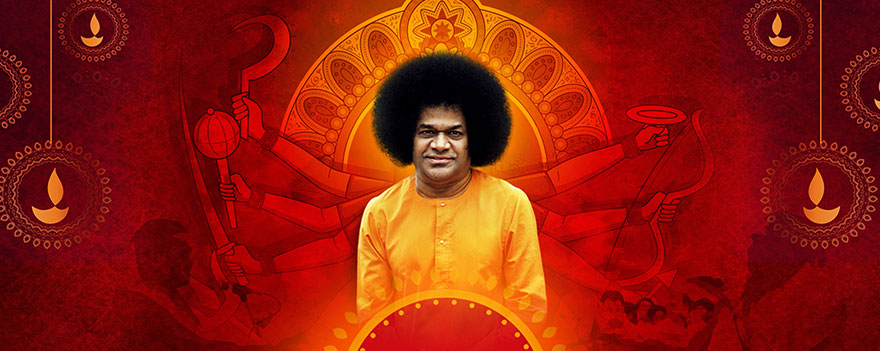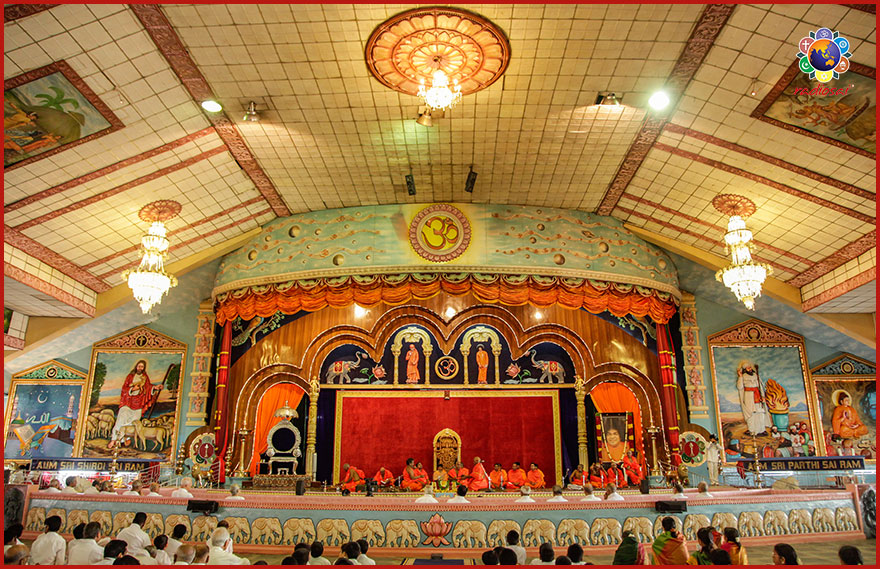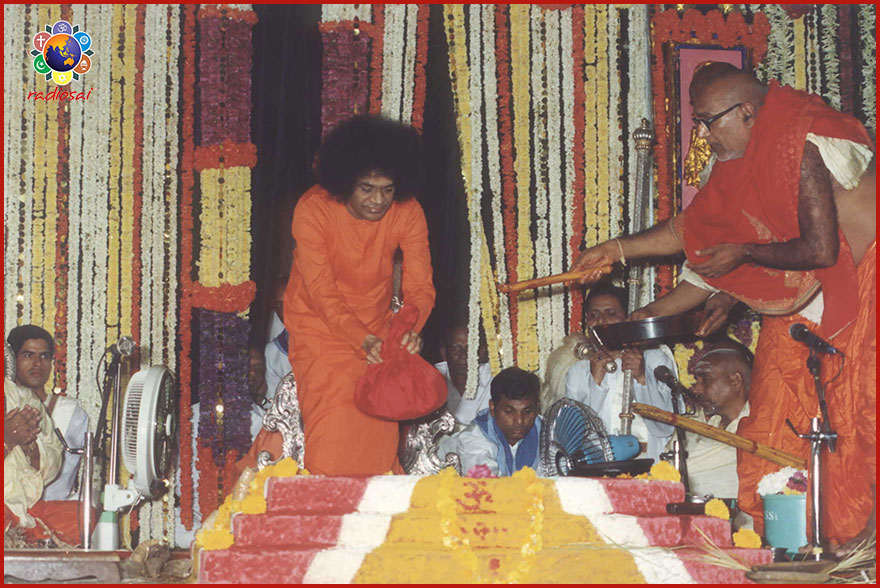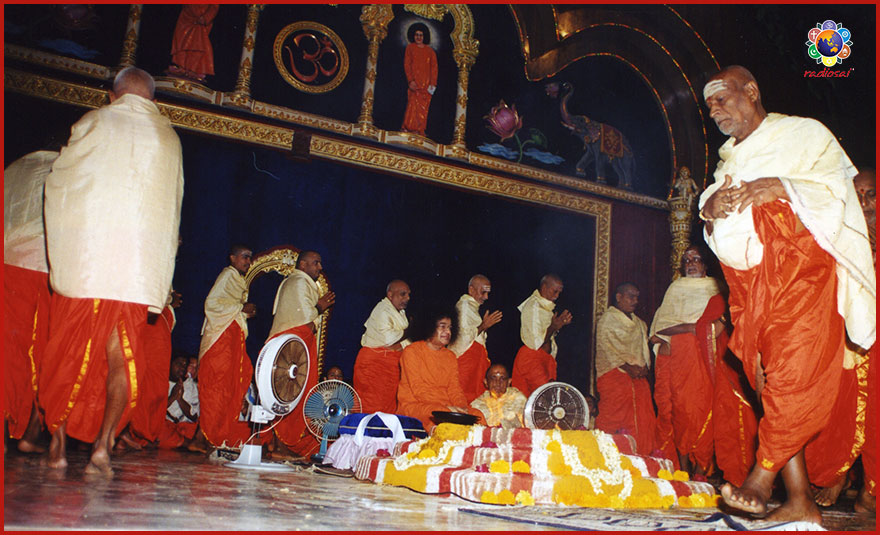| 'Like' us on Facebook | Follow us: |
Posted on: Oct 5, 2019
A Riveting Story Of Vedic Revival
- The Birth of the Veda Purusha Saptaha Jnana Yajna
 |
A root-cause analysis
Two gigantic oak trees stood tall, side by side, in the neighbouring fields of two farmers, just as they had stood for the past 100 years or so. One of them had rich foliage, lots of branches and had spread wider than the other. The thinner one with far lesser branches bore scars of multiple mutilations that its owner subjected it to. The regular pruning had prevented it’s spread. Ironically, the bigger tree had grown due to neglect. Its owner never bothered about it - neither pruned it nor nourished it. Then came the great storm, battering the village, the fields and everything in its wake throughout the night. The next morning, while the thin oak stood firm, the large oak had simply collapsed, seemingly under its own weight. The root cause was the root! While neglect had allowed it room to grow broad, the same neglect had got its roots infested with termites. Once root-rot sets in, any tree, however mighty, has to fall, isn’t it?
That was precisely the problem that Bhagawan Sri Sathya Sai Baba, (Swami for His devotees) addressed when He thundered on stage in 1965, during the Dasara celebrations at Prasanthi Nilayam in Puttaparthi:
“The Vedas are the roots of Dharma. If the roots are injured, the tree will die. The Vedas gave Ananda and Shanti (happiness and peace) that are lasting and sustaining. They transmuted all activity into worship of the Supreme and saved man from unending desires and inexplicable sorrow.”
But it was not mere preaching and proclamation. As has been His leadership model, Swami always follows the order - Be, Do, See & Tell. ‘Telling’ comes at the end of the cycle when the actions performed have already had a ‘telling’ effect. Those actions constitute the exciting story of the birth and growth of the Vedapurusha Saptaha Jnana Yajna and the Prasanthi Vidwan Mahasabha.
 |
| To this day, the Veda Purusha Saptaha Jnana Yajna continues to be held in all it's majesty with all strict observances during the Navarathri/Dasara festival at Prasanthi Nilayam. |
Fruition of a thousand prayers
It was the first day of October, at 9.30 AM in 1955, when Swami directed Swami Amrithananda to go into the interview room. The elderly Swamiji was despondent and had a forlorn look on his face. It was a barrage of love that followed as Swami consoled him without him even speaking a word.
“I know that you have a big sum of money which Ramana Maharishi advised you to use for Vedic revival. You invested it in the Benares Bank and later with some Trusts. You consulted Madan Mohan Malaviya, Bhagawan Das and Bal Gangadhar Tilak on how to go about your mission but your plan didn’t fructify. Money cannot revive the Vedas. Do not worry any more. The task of Vedic revival is no longer yours. It is Mine.”
The scriptures say that God’s Grace makes the dumb speak. It was the case of His grace making the erudite dumbstruck! Swami Amrithananda, true to his name experienced eternal, nectarous bliss, expressing it through a copious flow of tears down his wrinkled cheeks. He came out of the interview room, reassured and contented. Going to Prof. N. Kasturi, he confessed, “After a long time, I am at ease now. I feel my life has found fulfilment.” Swami Amrithananda died, peacefully, within two months of this transfer of burden!
A few years later, in January of 1960, a great Sanskrit scholar from Sorbonne, France, Valestin by name, who was in India to translate the commentaries on the Vedas into French, arrived at Prasanthi Nilayam. Swami granted him an interview during which, he suddenly caught His hands and pleaded,
"Baba! Vedic scholarship is fast declining in this Holy Land. You must revive it, You must foster it.”
It was as if the West too had joined the East, awaiting with palpitating hearts, the reply that Swami would give, because the Vedas are for both East and West - for all mankind. And Swami did not disappoint mankind. He said,
"I have come for that very purpose, for Vedic revival. It shall be done. I will do it. Wherever you are, you will know of it. The world will share that joy, that light".
Swami was just waiting for the perfect Desha, Kala and Paristhiti (Place, Time and Situation), and all three of them fell perfectly in place in 1962. It all began when the devotees from East Godavari region of the state of Andhra Pradesh received the happy news that Swami would be visiting them soon. They prayed to Swami that a Yajna be included in programme schedule during His visit. Swami granted them a bigger boon. He said they could as well celebrate the same Yajna in Prasanthi Nilayam during the year’s Dasara so that thousands of people from around the country could get the thrill & benediction of witnessing it. He also invited Vedic scholars from all around the country and not just the Konaseema (Coast in the basin of river Godavari) area in Andhra Pradesh (which had an abundance of Vedic scholars). He said, “My Seema (area) is not Konaseemma only; it is Veda-seema (all areas where the Vedas are revered).”
Veda Purusha Saptaha Jnana Yajna
 |
Thus was born the Veda Purusha Saptaha Jnana Yajna at 9:30 AM on the 1st of October, 1962, exactly 7 years after Swami’s promise to Swami Amrithananda. In fact, speaking on the inaugural day, Swami said,
“Today, long before the sun rose, I could see Bliss (Ananda) rising in your hearts, for you woke up long before dawn and got ready to come here for the inauguration of this ritual of sacrifice (yajna)! I had suggested 9:30 as the time for this event, but others suggested an earlier auspicious hour due to the showers that came this morning. My resolve prevailed, and we are meeting here to inaugurate the ritual at 9:30 itself!”
The Yajna consisted of two sections - the morning sessions for seven days of Athi-Rudra homa with all its complementary rites, and the evening sessions of a Jnana Yajna, where distinguished exponents of the Vedas explained to the vast gathering, the meaning and significance of the scriptural rites.
Scrupulous care was taken to observe all the Vedic injunctions, down to the minutest detail. Therefore, the number, size and location of the pillars of the Yajna Mantapam, the number and shapes of the sacrificial pits and the location of the shrines of subsidiary deities were all correctly fixed. Kusa grass seats were prepared for the participants and all the materials - ghee prepared from cow's milk, earth from ant-hills, royal equestrian and elephant stables, banyan tree twigs, spoons made of special wood - were collected under Swami’s personal supervision. Only one item sought by the strict officiating priests was absent - a vessel of a particular shape and size as prescribed by the scripture. Swami went inside and fetched a Kamandalu (an oblong water pot used by monks & holy men to store drinking water) which seemed to have been manufactured with these very prescriptions in mind! The story of that Kamandalu is thrilling indeed - an example of the Masterplan in action.
A Masterplan spanning decades
 |
|
| Abdulla Baba - the Saint from Shirdi |
Raja Saheb Bhimsen Rao and Rani Lakshmi Bai, the royal couple of the kingdom of Chincholi were devotees of Shirdi Baba and used to visit Shirdi for Baba’s darshan. The Rani had two sisters - Arani Rajamma & M.S.Seethamma - who were devout followers of Baba. Arani Rajamma’s son, Krishnaswamy visited Shirdi in 1946 and accosted Abdulla Baba. Abdulla Baba was another fakir, a saint & follower of Baba, who had mystical powers. He told Krishnaswamy that his family would be blessed by Shirdi Baba’s darshan within a year!
True to the word, Arani Rajamma & Seethamma came to know of Sathya Sai Baba from their friend Sakku (Nagamani Purnaiya’s sister) in 1947. They lived very close to Sakamma’s home and had their first darshan of Swami too. (Both Sakamma & Nagamani Purnaiya are well-known devotees of Bhagawan Baba). Soon, they accompanied Nagamani Purnaiya to Puttaparthi where Swami granted them an interview. In the course of the interview, Swami narrated all the travails they had undergone in life - from their parents’ families, Seethamma’s estranged husband, to their children. Blessing them, He told them to get their sister, Rani Lakshmi Bai, mother Namagiri Amma and the children for the upcoming Dasara.
 |
| Bhagawan with Members of Chincholi Royal family. Rani Lakshmi Bai is seated immediately to Swami's left. |
The leelas and mahimas they all witnessed during Dasara made them regular visitors to Puttaparthi, especially during Dasara.
 |
|
| A rare image of Bhagawan at Sriniketan, the residence of the Chincholi Rani at Hyderabad. |
In 1949, during His visit to Hyderabad, Swami stayed at the Rani’s home - Sriniketan. One day, Swami told the Rani that He had visited their palace at Chincholi. The Rani did not understand because this was Swami’s first visit to her place. Swami said most casually,
“I have been to your palace in my previous incarnation. I left my Kamandalu, Hookah (tobacco pipe) and robe there. The robe had been stitched with a needle used for stitching jute sacks. Each time I sat for a meal, that Kamandalu held my water.”
He then told the family to search for the described items in Chincholi. He also spoke the exact same words that Shirdi Baba had spoken to them during Baba’s visit to Chincholi. (Readers may wonder how the saint of Shirdi who, according to all accounts, never left Shirdi for years, could have gone to Chincholi and Hyderabad, and left a Kamandalu with the Raja. But, devotees who have seen and experienced the Avatar of Sri Sathya Sai Baba will have no difficulty on this score. In fact, it is the honest belief of the Rani as well as some old servants of the palace that Shirdi Sai Baba stayed a few days every time He came and that He used to ride in a Tonga drawn by bullocks far out of the town, in order to have talks with the Raja who accompanied Him). Swami also referred in detail to the renovations being carried out at the palace! He jokingly chided her for uprooting the Margosa tree during the renovation.
 |
| The Tonga which Shirdi Baba used to move around in the Chincholi kingdom. It is currently on display at the Chaitanya Jyoti museum at Puttaparthi. |
The earnest Rani returned to Chincholi to find every detail Swami had narrated to be true. Thus, she embarked on a search in the palace. Sure enough, in one of the storerooms, she came across a beautiful brass Kamandalu! She got it cleaned and polished and put it on display in the drawing room. The next day, a cobra had wrapped itself around that Kamandalu! The queen decided to leave immediately to Puttaparthi with the Kamandalu and ask Swami what needed to be done about it.
No sooner had she arrived, Swami asked her to fetch His drinking vessel. Picking up the Kamandalu, Swami turned it precisely to the spot where two Devanagari letters had been engraved - Saa and Baa. ‘Saa’ indicating Sai and 'Baa' for Baba! And that Kamandalu was now playing out its destiny as an integral item in the grand Yajna that would mark the revival of Vedic learning in the world!
The Veda Purusha directs & accepts the Yajna
 |
| The Vedapurusha - He is the one who offers, He is the one who receives |
It was a Yajna which can never be adequately described in words. Each and every person who participated in it, had a story to say, an experience to enunciate. Altogether 2,26,270 spoonfuls of ghee were offered during the seven mornings into the sacrificial fire, with the concurrent invocation of the appropriate Name of the Lord, describing one among His manifold characteristics!
Sri Uppuluri Ganapathi Sastri, a septuagenarian scholar, proclaimed that in his fifty years of experience of Vedic Yagas and Yajnas, he has not had the privilege of witnessing such a scrupulously correct Yajna, which could pass the most rigorous tests of orthodoxy. As a matter of fact, the discourses he gave every evening on the significance of the rites were filled with sincere gratitude to Swami for upholding the Vedic injunctions. He quoted Veda mantras in support of what looked like 'casual acts' by Swami - His reference to the rithwiks as 'gods', His distribution of white silk clothes to the reciters of the Vedas and red silk clothes to those engaged in other rites and even the order in which He presented awards to the participants at the end of the Yajna! Baba was the Vedapurusha, he acknowledged.
 |
| The Vedic scholars offer their obeisance to their Veda Purusha. |
Sri Kameshwara Ghana paati, left his native home in the far-off Godavari Delta and decided to stay on at Prasanthi Nilayam, where he found the Vedapurusha whom he had been extolling with mantras for sixty years! Sri Suryanarayana Sastri who rigidly refused to accept a ‘man’ as an incarnation of God, changed his views even before the Yajna concluded, confessing that "the conviction that Baba is Krishna, come again, is rooted deep in me". Sri Venkatasubba Sastri of Warangal, also a doubter, later said,
“The Viswarupa-darsanam vouchsafed by Krishna to Arjuna could be dismissed by cynics as a major magic performance. If the Lord presented Himself before them, they would attribute it to an optical defect or describe it as an apparition pictured by feverish imagination. I have applied the various tests prescribed by the Sastras and concluded that Baba is Bhagavadavathara-murti.”
All the scholars were in awe at the wisdom, love and light that emanated from Swami during the six discourses that He delivered in the evenings of the Yajna. These discourses have been beautifully summarised in the ‘Sathya Sai Speaks’ under the titles The Root of Dharma, Delusion and Brahman, Ghee and sandalwood, What is dharma, what is not?, The Brahmin and Valedictory offering in the sacred fire.
In all His discourses, in different ways, He exhorted the scholars to keep their faith in the Vedas steady as the Vedas are the reservoirs of Atmic Bliss.
"You may ask why Pundits and Vedic Scholars are passing through such hard times. They are mostly hungry, ill-clad and homeless. No one comes forward to join Vedic schools. I shall tell you why they have come to this pass. They have themselves lost faith in the Vedas. Let them be fixed in that faith - then, the Veda will make them happy. If the Veda cannot make a man happy, what else can?"
No wonder therefore that the dozens of scholars that basked for seven days in the sun of Swami’s grace decided spontaneously to arrange a unique function on the Tenth Day which they called ‘Tribhuvana Vijayam’ (Baba’s Triumph over the Three Worlds)! Yet again, amazingly, just before the function, a magnificent ‘Sesha Thalpa’ or ‘Serpent Couch’ shaped like Lord Vishnu’s bed - Adi Sesha - arrived to Puttaparthi from Mumbai. It was from a lady devotee who had a vision of Baba as Narayana on the Primeval Serpent (Sesha) Couch. So, she got it made in wood, complete with the coils and hood and had it brought to Prasanthi Nilayam, in a motor vehicle that had been specially reshaped for the purpose!
 |
| The vision which the devotee saw of Swami on the serpent, Adi Sesha probably looked like this. |
It was with that grand darshan of Swami as Mahavishnu that the first ever Veda Purusha Saptaha Jnana Yajna concluded. It is indeed awe-inspiring and goosebumps evoking to think that we get the opportunity to participate in this annual effort initiated by God for the resuscitation and restoration of the most ancient highway connecting man to Himself.
 |
"My Prema towards Vedas is matched by My Prema towards Humanity." - Baba
Thank you and loving Sai Ram,
Aravind Balasubramanya
Team Radio Sai
| comments powered by Disqus |
What are your impressions about this? Please share your feedback by writing to h2h@radiosai.org or listener@radiosai.org . Do not forget to mention your name and country please.






